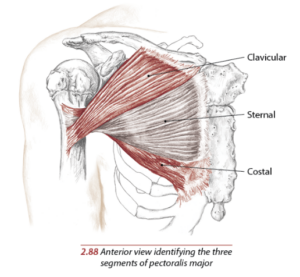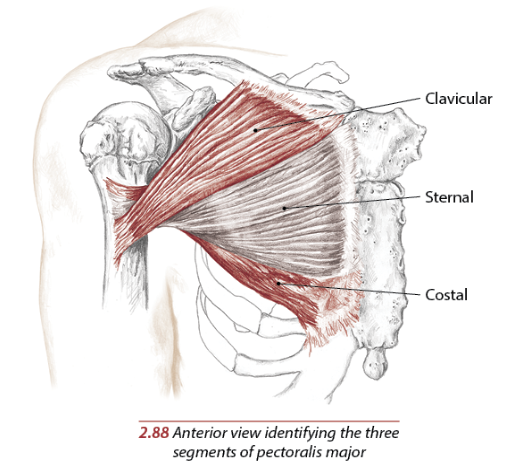Knowing where pectoralis major is located, how it moves the surrounding bones, and what exercises strengthen it is essential for exercise programming. Pec major is a large muscle in the upper body that influences shoulder movement, upper torso function, and breathing.
Most personal trainers and clients have an idea of where pec major is (compared to obturator internus). Understanding pec major beyond its basic location and mainstream function will set you apart as a personal trainer.
Let’s dive in and explore!
Pectoralis Major Location
Use these directions to find the attachment points on yourself and connect to where pec major attaches. Flex (raise forward) and adduct (move toward the midline) your arm while you palpate to feel the muscle contract and locate the attachments. Lying supine on a mat or table will help you locate this muscle the most accurately.

Origin: Medial half of clavicle, sternum, and cartilage of ribs 1-6.
- Find your sternum in the center of the upper chest and palpate to the side of it until you feel your ribs meeting it.
- Contracting your pec major by protracting your shoulder forward will cause a contraction.
- Follow the sternal attachment superior (up) to the inferior (lower) clavicle and continue protracting to identify this portion of pec major.
Insertion: Crest of greater tubercle of humerus
- Find the pec major tendon in your armpit, it’s a thick cord.
- Follow it to your anterior (front) armpit and onto your humerus bone.
- Pec’s tendon dives below the bicep muscle onto the medial humerus. If you feel a nerve (stinging) sensation, be gentle and work around it – you are close.
Pectoralis Major Action
- Adducts the glenohumeral joint (GH) (shoulder)
- Flexes the GH joint (upper fibers)
- Extends the GH joint (lower fibers)
- Internally (medially) rotates the GH joint
To explore these actions, identify the origin sites of pec major again and perform each action independently. You’ll feel the muscle tighten under your fingers as you move.
If you perform all three of these actions simultaneously pec major may feel like it’s contracting more strongly and completely.
Pectoralis Major Exercises
Any exercise that calls upon one of the actions mentioned above will recruit the pectoralis major into action. If you do an exercise combining all three actions it maximizes the potential for this muscle to contract.
- Chest press – unilateral or bilateral
- Push up
- Plank – forearms or hands
- Chest fly – unilateral or bilateral
- Front shoulder raise – unilateral or bilateral
- Adduction pull-down (pull a cable down to hip from the side) – unilateral or bilateral
- Lat pull down
- Pullovers
- Chin up and pull up
- Punch (boxing) – unilateral or bilateral
Pectoralis Major Stretches
To stretch the pectoralis major, perform the opposite movements of its action. If stretches cause too much discomfort, do one reverse action at a time. For maximal stretch perform all of the antagonistic motions together. If there is pain when stretching – for you or your clients, consult with a physician.
Antagonistic (opposite) actions for stretching
- Abduct the glenohumeral joint (GH) (shoulder)
- Extend the GH joint
- Externally (laterally) rotate the GH joint
Try these stretches
- Doorway stretch – place the palm in a doorway and walk forward slowly until a stretch is felt
- Foam Roller stretch – lying on a foam roller and spreading the arms wide out to the side and externally rotating
- Hands behind head stretch – place hands both behind the head and gently press the elbows back
Pectoralis Major Discomfort and Posture
It is common for people to sit with rounded shoulders and recruit pectoralis major more than its antagonistic muscles (latissimus dorsi, rhomboid, trapezius). This doesn’t necessarily mean pectoralis major is stronger than the other muscles.
It is important to train both sets of muscles as equally as possible. From there, the rest of this “poor posture” issue is often body awareness-related. Teaching clients to have good posture and carry the body with optimal alignment is a big part of the puzzle.
Pectoralis major is a dynamic and multi-function muscle. Identifying the attachments of origin and insertion enhances body awareness, which can increase performance and decrease the risk of injury.
References
Abrahams, P.H. et al. 2003. McMinn’s Color Atlas of Human Anatomy. London: Elseiver.
Muscolino, Joseph E. 2004. Musculoskeletal Anatomy Coloring Book. Philadelphia, PA: Mosby, Inc.




